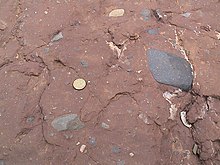Diamictite




Diamictite ( /ˈdaɪ.əmɪktaɪt/; from Ancient Greek dia- (δια): 'through' and meiktós (µεικτός): 'mixed') is a type of lithified sedimentary rock that consists of nonsorted to poorly sorted terrigenous sediment containing particles that range in size from clay to boulders, suspended in a matrix of mudstone or sandstone. The term was coined by Richard Foster Flint and others as a purely descriptive term, devoid of any reference to a particular origin.[1] Some geologists restrict the usage to nonsorted or poorly sorted conglomerate or breccia that consists of sparse, terrigenous gravel suspended in either a mud or sand matrix.[2]
Unlithified diamictite is referred to as diamicton.
The term diamictite is often applied to nonsorted or poorly sorted, lithified glacial deposits such as glacial tillite and boulder clay, and diamictites are often mistakenly interpreted as having an essentially glacial origin (see Snowball Earth). The most common origin for diamictites, however, is deposition by submarine mass flows like turbidites and olistostromes in tectonically active areas, and they can be produced in a wide range of other geological conditions. Possible origins include:[3][4]
- glacial origin
- meltwater flow deposition
- unsorted moraine glacial till
- basal melt-out
- ice rafted sediments deposited by melting icebergs or disintegrating ice sheets (dropstones)
- volcanic origin
- lahars
- lahar mass flows entering the ocean
- marine origin
- debris flow
- turbiditic olistostromes
- mixing of sediments by submarine landslides
- tectonic origin
- erosional origin
- regolith, in the form of a debris flow
- other mass wasting events
- extraterrestrial origin
References[edit]
- ^ Flint, R.F., J.E. Sanders, and J. Rodgers (1960) Diamictite, a substitute term for symmictite Geological Society of America Bulletin. 71(12):1809–1810.
- ^ Tucker, M.E. (2003) Sedimentary Rocks in the Field John Wiley & Sons, Ltd., New York, New York. 244 pp. ISBN 978-0-470-85123-4
- ^ Eyles, N.; Januszczak, N. (2004). "’Zipper-rift’: A tectonic model for Neoproterozoic glaciations during the breakup of Rodinia after 750 Ma". Earth-Science Reviews 65 (1-2): 1-73. (pdf 4 Mb) Archived 2007-11-28 at the Wayback Machine
- ^ Huber, H., Koeberl, C., McDonald, I., Reimold, W.U.: Geochemistry and petrology of Witwatersrand and Dwyka diamictites from South Africa: Search for an extraterrestrial component. Geochimica et Cosmochimica Acta, Vol. 65, No. 12, pp. 2007–2016, 2001. (pdf 470 Kb)
Further reading[edit]
- Deynoux, M., et al. (Editors) (2004) Earth's Glacial Record, Cambridge University Press, pp. 34–39 ISBN 0-521-54803-9
